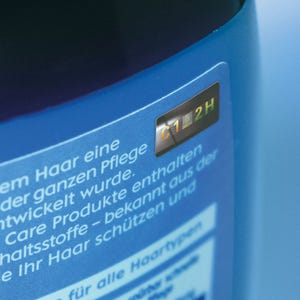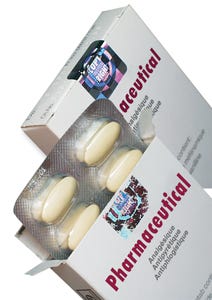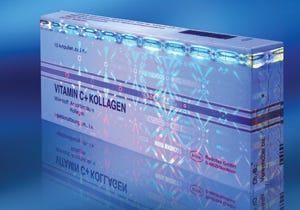January 30, 2014
|
Sophisticated replication techniques have made counterfeiting and fraud a serious threat to the pharmaceutical and medical industry—and to the suppliers to the sector, like packaging companies.
The World Health Organization (www.who.int) estimates that annual earnings from the global sales of counterfeit and substandard medicines are more than $32 billion, while counterfeit drugs and packaging put people's lives at risk. Diversion of legitimate product outside authorized distribution channels is another problem.
In response to this problem, many of the world's leading pharmaceutical and medical companies have directed their efforts at authenticating their packaging as part of the process of protecting their products. As a result, diffractive, optically-variable devices—referred to generically as holograms—have become one of the most widely used overt authentication features on pharmaceutical products around the world.
Caught on quickly
Since Glaxo first used a tamper-evident hologram to seal packages of Zantac in 1989, holograms have been utilized in a big way by the pharma/medical industry. Many major drug companies use holograms on at least some of their medicines in selected markets, and they are used in the form of labels, seals, hot-stamped patches and blister-pack foils.
The ability of a hologram to provide effective protection lies in the continuous innovation, invention and evolution in holographic techniques that have succeeded in creating increasingly complex devices that are easily recognized yet difficult to copy accurately.
The evolving role of the hologram also has been accompanied by the increased use of the security device in combination with other authentication technologies. In such solutions, holograms often provide overt first-line authentication while covert features such as scrambled images, micro-text and UV-sensitive or other specialty inks provide second-line authentication for trained examiners equipped with appropriate decoding equipment.
Track and trace
Another trend has seen the serialization of holograms as part of systems that combine authentication with traceability. So-called track-and-trace systems link on-pack security devices with database management and field-tracking services.
In this way, the ability to know where a pharmaceuticals consignment has been, where it is now and where it is heading has become a fundamental part of many drugs companies' production and logistical operations. This is particularly important where the ability to identify the source and provenance of products is becoming a mandatory requirement, as it is in the U.S. with the Food and Drug Administration's and some state requirements for pedigree.
While the U.S. Congress is currently considering making the use of security marking on some pharmaceutical products mandatory using “overt, optically variable counterfeit-resistant technologies” to protect consumers from fakes, the hologram is already specified as the authentication feature on the world's only statutory pharmaceutical marking scheme—the Meditag program in Malaysia.
Uniquely-numbered holograms
|
This initiative requires all registered medicines, over-the-counter (OTC) pharmaceuticals and traditional medicines to carry a uniquely numbered label built around a hologram. The system is supervised by a central authority that controls the issue of tags and trains inspectors to examine holograms through the distribution chain.
Since its introduction, the system has led to a significant increase in the identification and confiscation of illegal items from the market and prevented their entry into distribution channels. As a result, consumer confidence in the integrity of pharmaceuticals has increased, and public health has been safeguarded. More recently, the National Agency for Food & Drug Administration and Control in Nigeria has also announced that it is planning to introduce uniquely numbered holographic labels to be used on all licensed medicines distributed in that country.
Perhaps unsurprisingly, the success and near ubiquitous use of holograms in anti-counterfeiting applications has inevitably led to attempts to copy or replicate them. But the intrinsic features of holograms mean that the techniques and visual effects make it very difficult to copy a properly conceived and executed authentication hologram with 100-percent accuracy.
Historically, holograms have succeeded in their job to fight counterfeiting. They have proven to be extremely difficult to copy accurately and invariably. While the product and packaging they protect may have been counterfeited, the lower-quality copy of the hologram has more often than not been the feature that has demonstrated that it is a counterfeit.
In this way, the hologram serves as an effective detection feature, when sophisticated criminals have the resources to reproduce packaging that is barely distinguishable from the genuine—the same cannot be said of the fake holograms.
As an example, the situation involving an important anti-malarial treatment called Artesunate, is often quoted. More than half of the sales of this drug in Southeast Asia are reportedly of fake product, despite the fact that its blister-pack incorporates a hologram.
What can be seen here is that, despite the fact that the hologram used is relatively simple and has been unchanged for several years, the fake holograms are identifiable as such.
The problem is that in a region of low rural literacy, very high poverty and very poor drug regulation, where medicines are sold in street markets and nonspecialist shops, most buyers and users of Artesunate see a hologram and think that it means that the medicine is genuine.
The overall conclusion should be that the Artesunate case is a classic example of how not to manage a hologram-authentication program on a brand of medicine. The hologram [for actual Artesunate] has not been redesigned since it was first introduced and insufficient attention was paid to the distribution, examination and purchasing patterns in the region.
In contrast, there are many examples of how holograms continue to provide a successful and vital detection function in pharmaceutical anti-counterfeiting strategies. In all of these cases, it is widely understood by those involved that formal inspection of the hologram provides the quickest way to identify a fake product, even if this then needs to be supported by forensic examination.
|
Importantly, as well as understanding the need to invest in the creation of a properly designed secure hologram, those pharmaceutical companies and organizations involved in successful anti-counterfeiting efforts also recognize that it should not be the sole responsibility of the consumer to examine a hologram to check that the product is genuine.
Rather than rely on untrained members of the public to identify counterfeits, it must be the primary responsibility of manufacturers and the enforcement agencies to ensure that fake pharmaceuticals not be able to enter the legitimate supply chain in the first place. This is why successful brand protection programs now involve formal examination and inspection systems at different stages in the distribution network.
Teaming authentication with detection
The holographic industry is working hard to destroy the myth that sophisticated holograms cannot be counterfeited. Anything can be counterfeited; the question is how well it can be counterfeited, and this is where the real value of holograms should be appreciated.
The evolving anti-counterfeiting role of holograms lies in their ability to combine authentication with detection—that's why enlightened pharmaceutical companies and enforcement agencies continue to make them an integral part of anti-counterfeiting strategies.
The International Hologram Manufacturers Association (IHMA) comprises more than 80 of the world's leading hologram companies. Members are leading producers and converters of holograms for banknote security, anti-counterfeiting, brand protection, packaging, graphics and other applications. More information is available atwww.ihma.org.
You May Also Like





